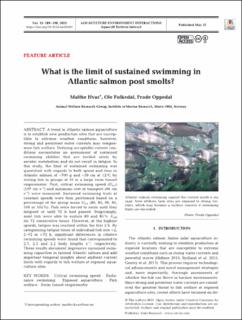| dc.description.abstract | A trend in Atlantic salmon aquaculture is to establish new production sites that are susceptible to extreme weather conditions; however, strong and persistent water currents may compromise fish welfare. Defining acceptable current conditions necessitates an assessment of sustained swimming abilities that are fuelled solely by aerobic metabolism and do not result in fatigue. In this study, the limit of sustained swimming was quantified with regards to both speed and time in Atlantic salmon of ~700 g and ~39 cm at 12°C by testing fish in groups of 10 in a large swim tunnel respirometer. First, critical swimming speed (Ucrit) (107 cm s-1) and minimum cost of transport (66 cm s-1) were measured. Sustained swimming trials at constant speeds were then performed based on a percentage of the group mean Ucrit (80, 85, 90, 95, 100 or 105%). Fish were forced to swim until they fatigued or until 72 h had passed. Surprisingly, most fish were able to sustain 80 and 85% Ucrit for 72 consecutive hours. However, at the highest speeds, fatigue was reached within the first 2 h. By categorizing fatigue times of individual fish into <2, 2-72 or >72 h, significant differences in relative swimming speeds were found that corresponded to 2.7, 2.5 and 2.2 body lengths s-1, respectively. These results document impressive sustained swimming capacities in farmed Atlantic salmon and add important temporal insights about ambient current limits with regards to fish welfare at exposed aquaculture sites. | en_US |
